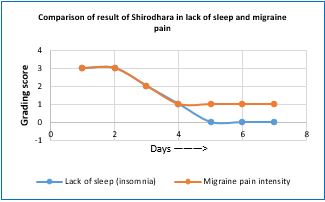Management of Chronic Migraine (Ardhavabhedaka) through Ayurvedic herbo-mineral drugs : A Case Study
Abstract
Migraine is a neuro vascular disorder characterized by recurrent attacks of pulsatile headache of varying intensity and is generally accompanied with nausea and vomiting, sensitive to light and sound. It is most common headache that generally afflicts ~15% of women and 6% of men. WHO has ranked migraine as a no. 19 among all the diseases worldwide causing disability. In Ayurveda it is well correlated as Ardhavabhedaka, one of the Shiroroga out of 11 mentioned by Acharya Sushruta based on the similarities in etiology, pathophysiology, symptoms and treatment principles. Ardhavabhedaka is a Tridoshaja Vyadhi. In allopathic Science many pharmacological strategies like, Antidepressants, Antiseizure drugs, and BP lowering medications (In hypertensive) are commonly used for the quick relief from Migraine pain but it adds drowsiness, insomnia and depression too; as a complication. This case study is about a patient having Chronic migraine for 3 years with generalized burning sensation all over the body, insomnia and stress. Ayurvedic Management with inclusion of Panchkarma procedures like shirodhara and nasya along with internal herbomineral medications have helped immense to get rid off the symptoms.
Downloads
References
Charak Samhita with elaborated Vidyotini Hindi commentary, by Pt.Kashinath Shastri and Dr Gorakh Nath Chaturvedi, Chaukhamba Bharti Academy, Varanasi, Nidan Sthan, 2018; 6/7
Ralston, S. H., Penman, I. D., Strachan, M. W. J., & Hobson, R. (Eds.). (2018). Davidson’s principles and practice of medicine (23rd ed). Elsevier Health Sciences
Charak Samhita by Agnivesa Revised by Charaka and Dridhabala with the Ayurveda Dipika commentary of Chakrapanidatta. edited by Vaidya Jadavji Trikamji Acharya; Chaukhamba Orientalia Varansi. Chapter 7/16
Kajariya Divya, Tripathi JS, Tiwari S.K An Appraisal of the mechanism of action of Shirodhara; Annals of Ayurvedic Medicine Vol -2 Issue 3 July-Sept 2013
Anonymous, Ayurved Saarsangraha, Shodhan-Maran-Prakaran by Shree Baidynath Ayurved Bhawan Ltd. page no 181
Mangal, A., Pali, S., & Makhija, P. (2021, March 27). Efficacy of an Ayurvedic Intervention in the Management of Migraine: A Case Report. International Journal of AYUSH Case Reports, 5(1), 19-23. Retrieved from https://www.ijacare.in/index.php/ijacare/article/view/191
Brinda Kanakhara and Varsha Chaudhari ; A pilot study on clinical efficacy of Agnikarma and Pathyadi decoction (An Ayurvedic Formulation) in the management of Ardhavabhedaka (migraine) available from https://www.ncbi.nlm.nih.gov/pmc/articles/PMC6287398/
An overview on Ashwagandha: A Rasayana (Rejuvenator)of Ayurveda, Afr J Tradit complement Altern Med .2011;8 (5suppl):208-213 published online 2011 July 3 Available from; https://www.ncbi.nlm.nih. gov/pmc/articles/PMC3252722/
M. Shreevastha, B. Ravishankar, Rambabu Dwivedi; Antidepressant activity of Mamsyadi Kwatha : An Ayurvedic Compound Formulation available from https://www.ncbi.nlm.nih.gov/pmc/articles/PMC3764868/#!po=71.1538

Copyright (c) 2022 Mohammad Aamir, Laljee Prasad, Amber, Sujeet Kumar

This work is licensed under a Creative Commons Attribution-NonCommercial-ShareAlike 4.0 International License.
Journal of Ayurveda and Integrated Medical Sciences (JAIMS) retains the copyright of the contents of this journal but grant the readers the right to use the contents with terms and conditions under a creative common attribution licenses 4 of Attribution, Share Alike and Non-commercial type (CC BY-NC-SA) that allows copy, distribute, display, and perform the work and make derivative works based on it only for non-commercial purposes.

This work is licensed under a Creative Commons Attribution-NonCommercial-ShareAlike 4.0 International License.












